How many times have you visited a restaurant on a friend’s recommendation or bought a product because your peers rated it five stars and gave positive reviews from their experience? This is referral marketing.
Referral email marketing uses existing customers to attract new ones through referral email programs. These customers buy more and refer 30-57% more new customers than others, showing customer referrals are contagious.
This blog covers the framework and best practices to help you write effective referral emails. We’ll share 15 real-world examples and referral email templates with tips on automating referral email campaigns.
What Are Referral Emails? Key Benefits of Using Them
Referral emails are marketing emails sent to existing customers, encouraging them to refer friends, family, or colleagues to a product or service, often in exchange for a reward. These emails are a core component of referral marketing programs and are designed to create a viral loop where one happy customer brings in another, and the process continues.
Referral emails offer a win-win situation where both the referrer and the referee can claim a reward or offer for new sign-ups. This motivates users to spread the word about the referral program, and marketers hit two goals with one stone: getting more sign-ups and word-of-mouth marketing and promotion.
These emails are typically triggered based on behavioral cues or customer lifecycle stages, such as post-purchase, post-NPS survey, or after the user reaches a product usage milestone, to maximize the likelihood of share intent.

A referral email typically contains:
- A clear explanation of the referral offer
- A unique referral link or code
- Strong calls-to-action (CTAs) encouraging sharing
- Details on what both the referrer and the referred person receive
Key Benefits of Referral Emails
Mentioned below are some major benefits of referral email marketing.
- Low Customer Acquisition Cost (CAC): Referral emails turn your current customers into a powerful acquisition channel, reducing dependency on expensive ads or paid media.
- Increased Trust: More than 90% of customers trust word-of-mouth referrals more than other forms of marketing. Referral emails amplify word-of-mouth, making your brand more credible and approachable.
- Higher-Quality Leads: Referral emails are a good source of lead generation via email marketing. Leads from referrals tend to convert better because they come pre-qualified through trust in the referrer. Referred customers bring a 25% higher profit margin and are 18% more loyal than a customer acquired by other means.
- Enhances Customer Engagement and Loyalty: Encouraging referrals gives existing customers a reason to stay connected and engaged with the brand, especially when incentives are involved. Referred customers have a 16% higher lifetime value compared to non-referred ones.
- Scalable: As the customer base grows, the brand reach expands exponentially, as each new customer can become a referrer, creating a compounding effect.
The A.I.R. Framework for Writing Effective Referral Emails
Every high-performing referral email does three things well. It captures attention, communicates value, and builds trust. Use the A.I.R. Framework to ensure your referral emails check all three boxes.
A – Attract With Clarity
Your email has seconds to make an impression, so lead with clarity and intent.
- Subject Line: Use benefit-driven language that sparks curiosity or highlights the reward. Example: “Get $50 when your friends sign up”.
- Headline: Reinforce the offer in bold, clear, and attention-grabbing terms. Avoid vague messaging as clarity boosts email conversion rate.
- Body Copy: Explain the action and its value clearly, using bullets or short paragraphs.
- CTA: Make the CTA visually prominent and action-oriented. Examples: “Share Your Link” or “Invite Friends & Earn”.
I – Incentivize with Value
A good referral program is a win-win. Your email should clearly reflect that.
- Mutual Benefit: Explain the reward structure by mentioning what the referrer gets and what the referred person gets. For example: “You get $50, they get $20 off”.
- Incentive Framing: Use aspirational language wherever possible. For example: “Help your friends and get rewarded”, “Spread the love and earn perks”.
- Relevance: Ensure the incentive resonates with the audience. It can be in the form of cash, discounts, early access, or exclusive perks. Test what drives action in different email segments.
R – Reinforce with Trust
Trust makes sharing feel safe and natural.
- Brand Voice: Stay consistent with the brand’s voice and tone, whether it’s friendly, professional, or playful, to maintain credibility.
- Social Proof: Mention how many other customers have already referred or include a short testimonial. Example: “Join 10,000+ users who’ve shared this offer”.
- Urgency and Scarcity: Add the element of fear of missing out (FOMO) tactfully by using limited-time rewards, countdowns, or language like “Only for the next 3 days.”
- Security Reassurance: Let users know their friends won’t be spammed, and that sharing is simple and secure.
You might like to read: 35 email marketing best practices to improve your campaigns.
15 Referral Email Examples to Drive Signups and Shares
Mentioned below are 15 examples of real-world referral emails and referral email newsletters from brands that know what they are doing.
1. Hylo: Referral Email Post Sign-Up
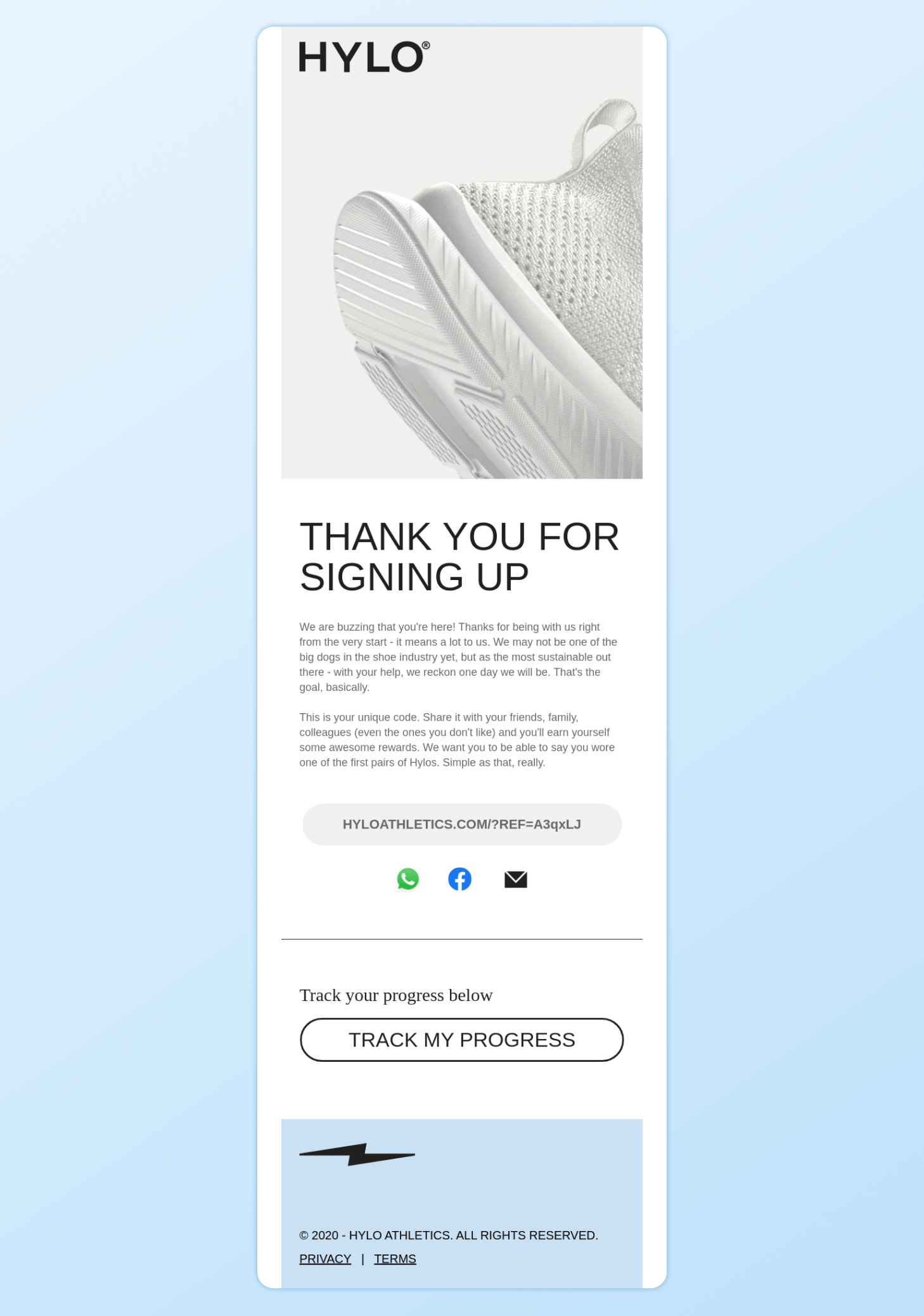
The subject line is crisp and to the point. It clearly mentions the purpose of the email. The welcome email thanks the user for signing up, showing gratitude, and offers a unique code to share with friends and family. The tone is friendly and playful.
The company shows humility by mentioning that they might “not be the big dogs of the shoe industry” while tapping into exclusivity and pride: “We want you to be able to say you wore one of the first pairs of Hylos.”
The layout is single-column and clean, with generous spacing and large buttons, making it perfect for mobile users. Visual sharing cues via WhatsApp, Facebook, and email make it effortless to spread the word, increasing virality. The CTA to “Track My Progress” adds a gamified element, encouraging continued engagement.
2. Rooted: Post-Purchase Referral Email

This email from Rooted is a great example of how to deliver a functional, engaging post-purchase experience. The bold, cheerful headline instantly celebrates the customer’s purchase, reinforcing positive emotions.
The step-by-step unboxing guide is visually driven, making it easy to follow and reducing the risk of damaging the plants during unpacking, a crucial touch for customer success. The tone is fun and casual, with friendly humor like “don’t kill it,” which helps humanize the brand.
A “Refer a friend” CTA at the bottom smartly drives ongoing engagement with a reward incentive. Overall, this email successfully combines education, personality, and loyalty in a single, memorable experience.
3. Going: Exclusivity and Urgency
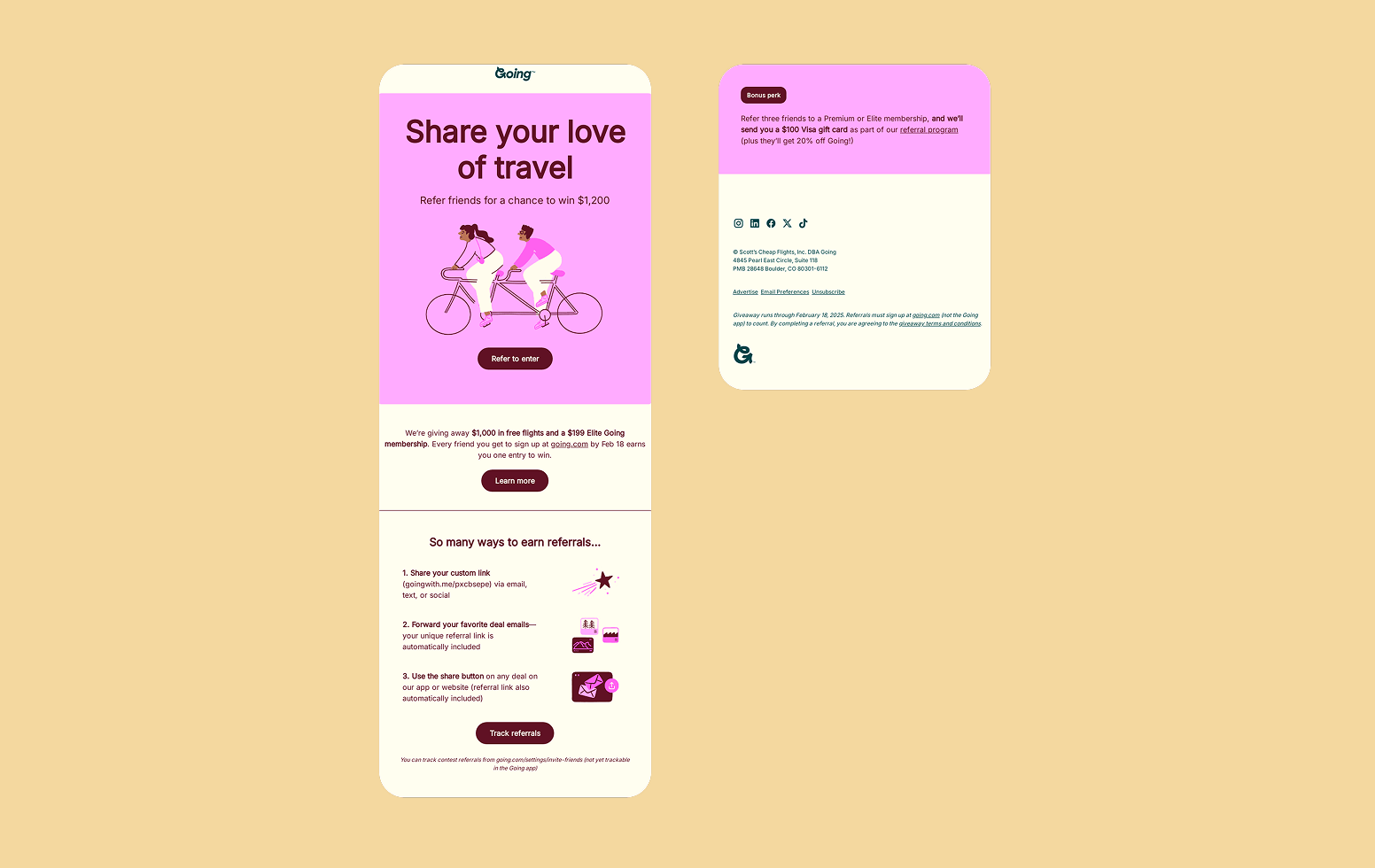
The email by Going uses visual hierarchy to guide the user’s eye towards the CTAs ‘Refer to enter’, ‘Learn more’, and ‘Track referrals.’ It instills a sense of urgency by mentioning that the recipient has to refer a friend by February 18 to increase their chances of winning.
Clear and vibrant images convey the idea of friendship and community. The steps to earn the referrals are clearly outlined using a numbered list. This offer also contains a bonus perk, making it extra special.
4. Saucey: Women’s Day Referral Email
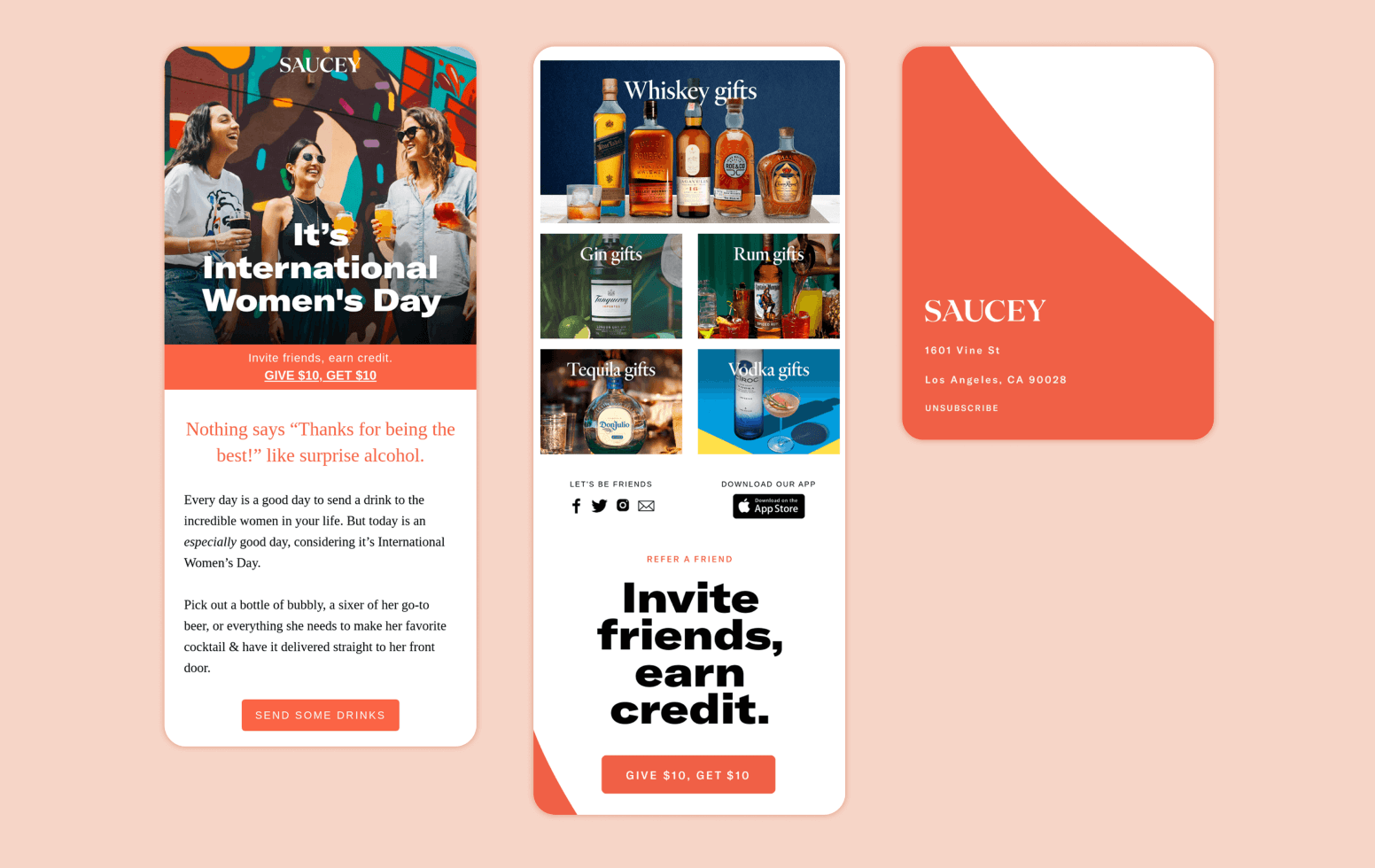
This referral email from Saucey works because it cleverly combines celebration with incentive. By tying the message to International Women’s Day, it feels timely, thoughtful, and relevant.
The referral offer, “Give $10, Get $10,” is clearly communicated and repeated twice, once at the top and again at the bottom, to ensure visibility and drive action. The tone is casual and friendly, aligning with the brand’s fun image, while the visuals are vibrant and engaging.
The structure guides readers smoothly from the celebration message to product options and ends with a strong call to action. By integrating the referral naturally into the occasion, the email avoids being overly promotional and instead feels like a shared experience.
5. Cometeer: International Coffee Day Referral Email

The referral email from Cometeer is effective due to its bold, simple messaging and strong incentive. The headline: “$50 for you, $50 for them” immediately communicates the benefit, using symmetry to make the offer feel fair and generous.
The supporting image of two friends sharing coffee reinforces the social element, aligning perfectly with the message that “coffee is better with friends.” The email copy is concise and friendly, with a clear deadline of October 5th, to create urgency. The black-and-white design adds sophistication while making key elements pop.
6. Brondell: Referral Program Announcement

The Brondell referral email stands out for its clarity, simplicity, and effective design. The subject line, “Tell a friend about us. Get rewarded,” immediately communicates what the email is about. The body of the email succinctly explains the process: share our loyalty rewards program with someone you know and earn $20 towards Brondell products when they spend over $99+.
Visually, the email maintains a clean and uncluttered layout, ensuring that the key message and CTA are prominently displayed. Additionally, the email aligns with Brondell’s brand values by using an image that shows a clean, healthy space with Brondell’s best-selling advanced bidet toilet seat with side arm control.
7. Equal Parts: Tiered Incentive Referral Email

This Equal Parts referral email works well because it combines warmth, urgency, and tiered incentives to drive action. It opens with a personal and appreciative tone, making recipients feel valued regardless of their referral count.
Visually, the colorful, winding path effectively guides the eye through the reward tiers, making the benefits tangible and easy to understand. Including the personal referral link within the email reduces friction and encourages immediate participation. The playful yet minimal design reflects Equal Parts’ brand and keeps the focus on the offer.
8. Flowium: Feedback-Driven Referral Email
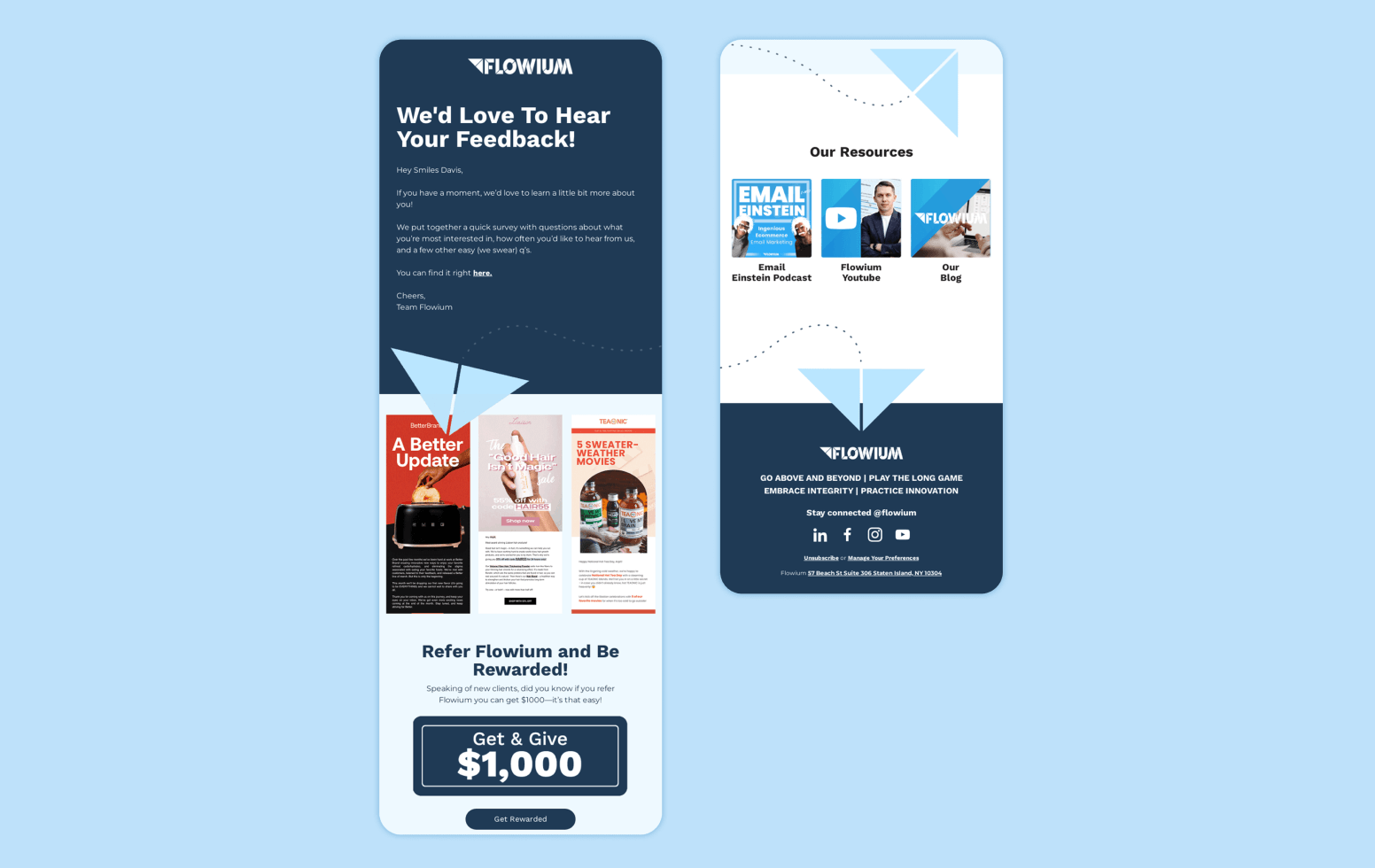
The email by Flowium subtly plugs in a referral program while asking the customer for feedback. This is an intelligent method because chances are, if the customer likes the product or service, they are more likely to refer a friend.
The CTA is hard to miss with ‘Get & Give $1000’ written in a larger font size than the other body text. The instructions are clear and straightforward. The subject line humbly asks if the recipient has a second to partake in the survey, and then guides the eye to the referral sections using well-designed layouts.
9. Southwest Airlines: Bonus Points Referral Email

The Southwest Airlines referral email is a masterclass in clarity and motivation. With a bold headline promising up to 100,000 points, it immediately captures attention. The clean, brand-consistent design highlights the reward of 20,000 points per referral, while using vibrant colors and credit card visuals to build trust.
A strong, centralized CTA button “Invite now” encourages quick action, and a shareable link is prominently displayed to simplify referrals. The step-by-step “How it works” section uses clear icons and language to reduce friction, making the process feel easy.
10. Airbnb: Incentivized Referral Email
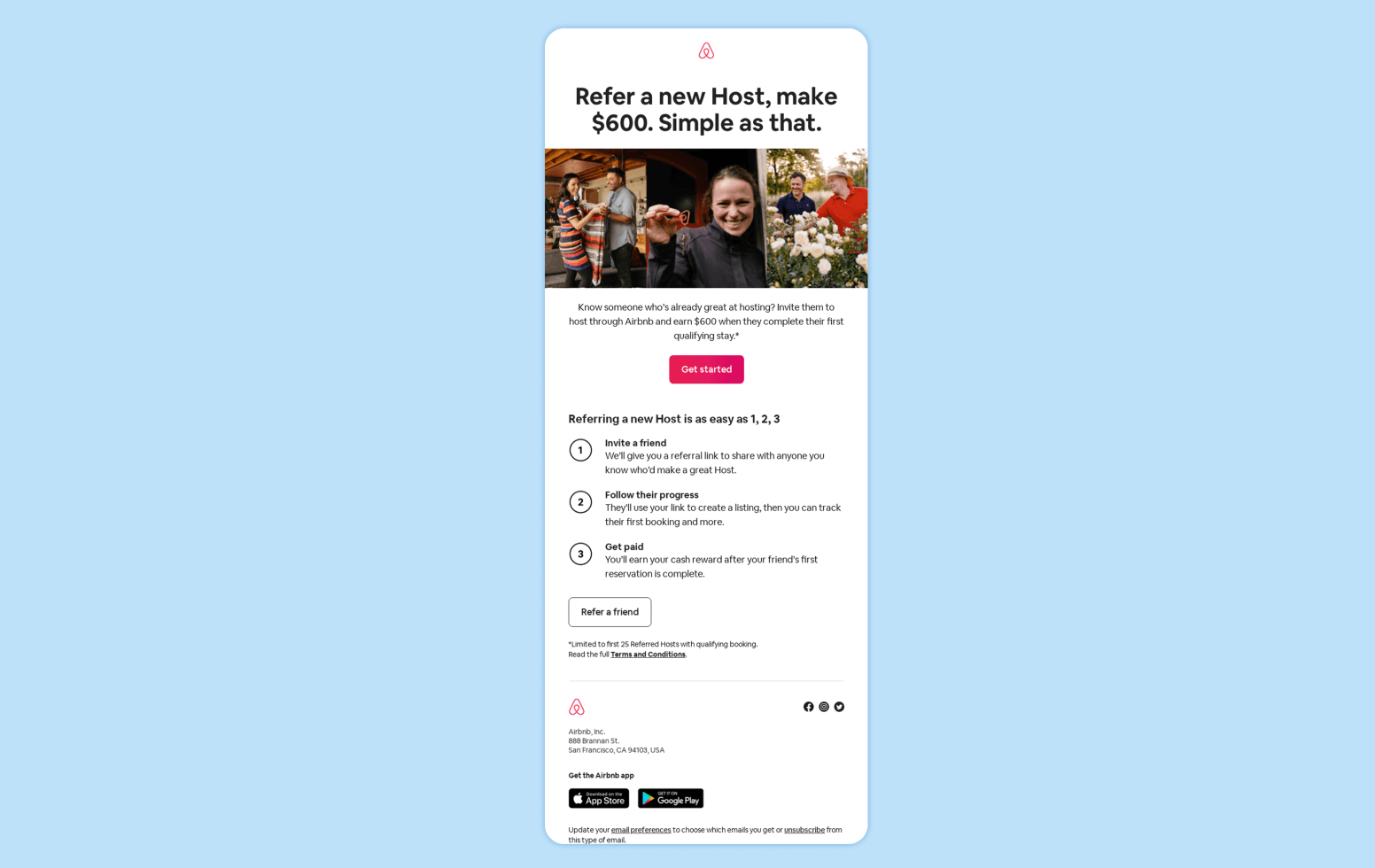
The Airbnb referral email uses a simple and incentive-driven design. It leads with a bold headline: “Refer a new Host, make $600. Simple as that,” immediately communicating the value proposition.
The use of real, happy hosts in the imagery builds trust and relatability. The central CTA “Get started” is brightly colored and positioned for visibility, encouraging quick action. A three-step process makes the referral journey feel easy and achievable, even for first-timers.
11. Going: Referral Program Email
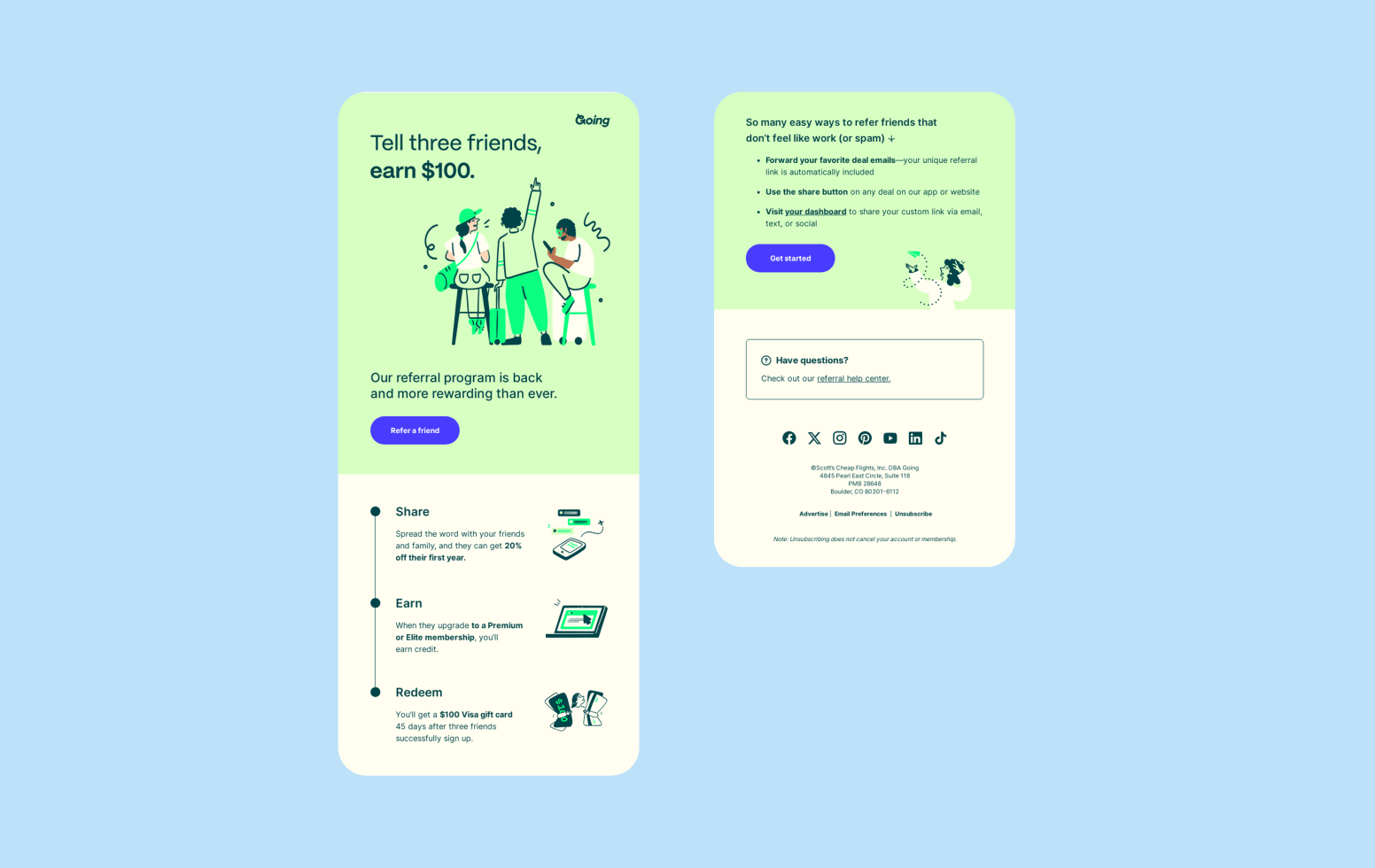
Going is back on the list with another strong referral email, and this time it is focused on a direct cash incentive. The bold headline, “Tell three friends, earn $100,” immediately captures attention and communicates the reward. The copy is friendly, simple, and structured around three clear steps: Share, Earn, and Redeem.
Visually, it’s clean and bright, with playful illustrations and standout CTA buttons that guide the reader naturally. This second campaign from Going showcases their versatility—using both urgency (as seen in their earlier example) and simplicity to appeal to different user motivations.
12. MeUndies: Refer a Friend Email
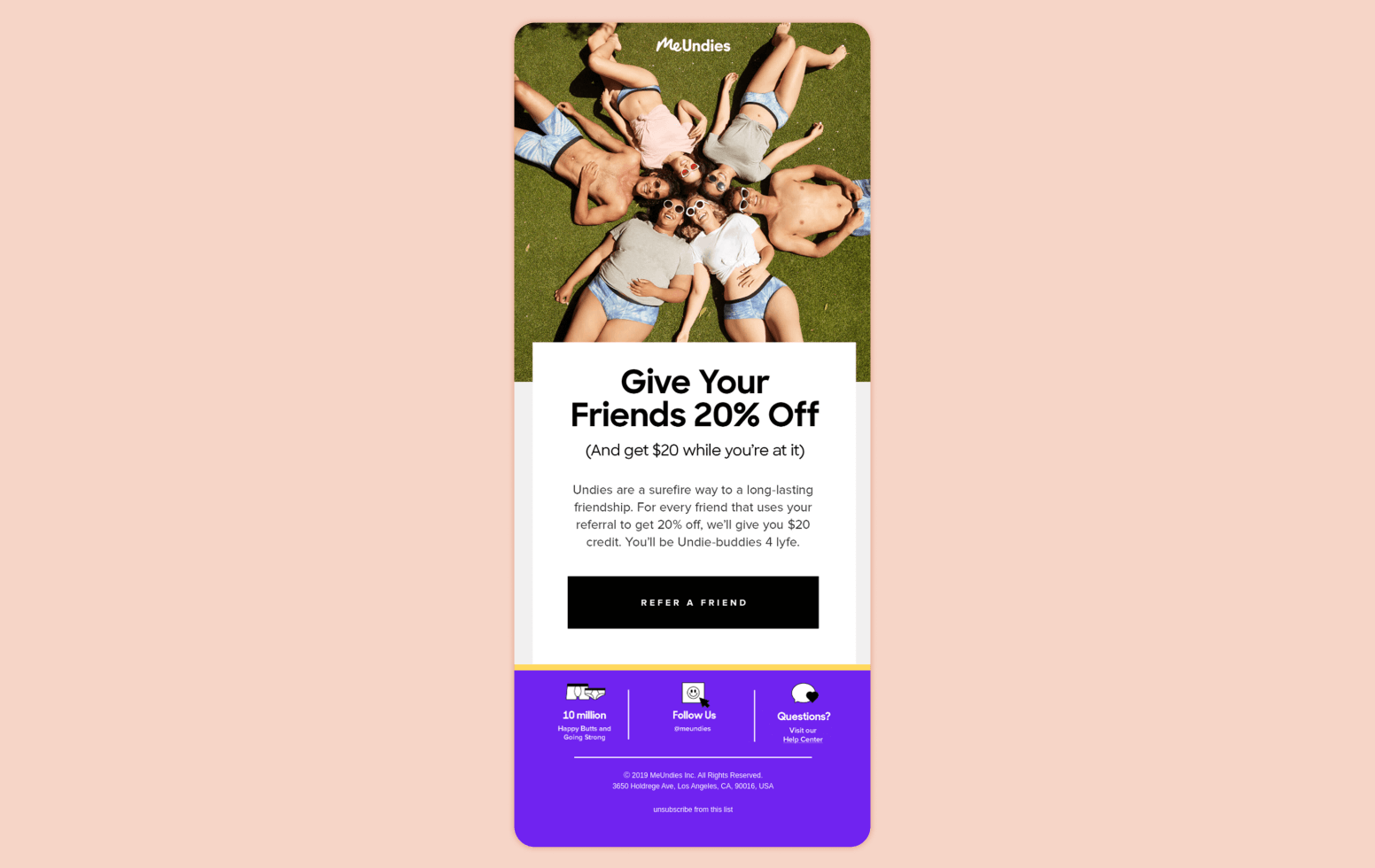
The playful subject line “Spread the Love And Get PAID💰,” combined with bright visuals and casual language, makes the offer feel friendly rather than transactional.
The copy leans into feel-good language like “Give your Friends 20% (And get $20 while you’re at it)” which builds a sense of community (You’ll be Undiebuddies 4 lyfe) and mutual benefit. A clear CTA and concise explanation ensure the message is easy to understand.
13. Ōura: Exclusive Offer Referral Email
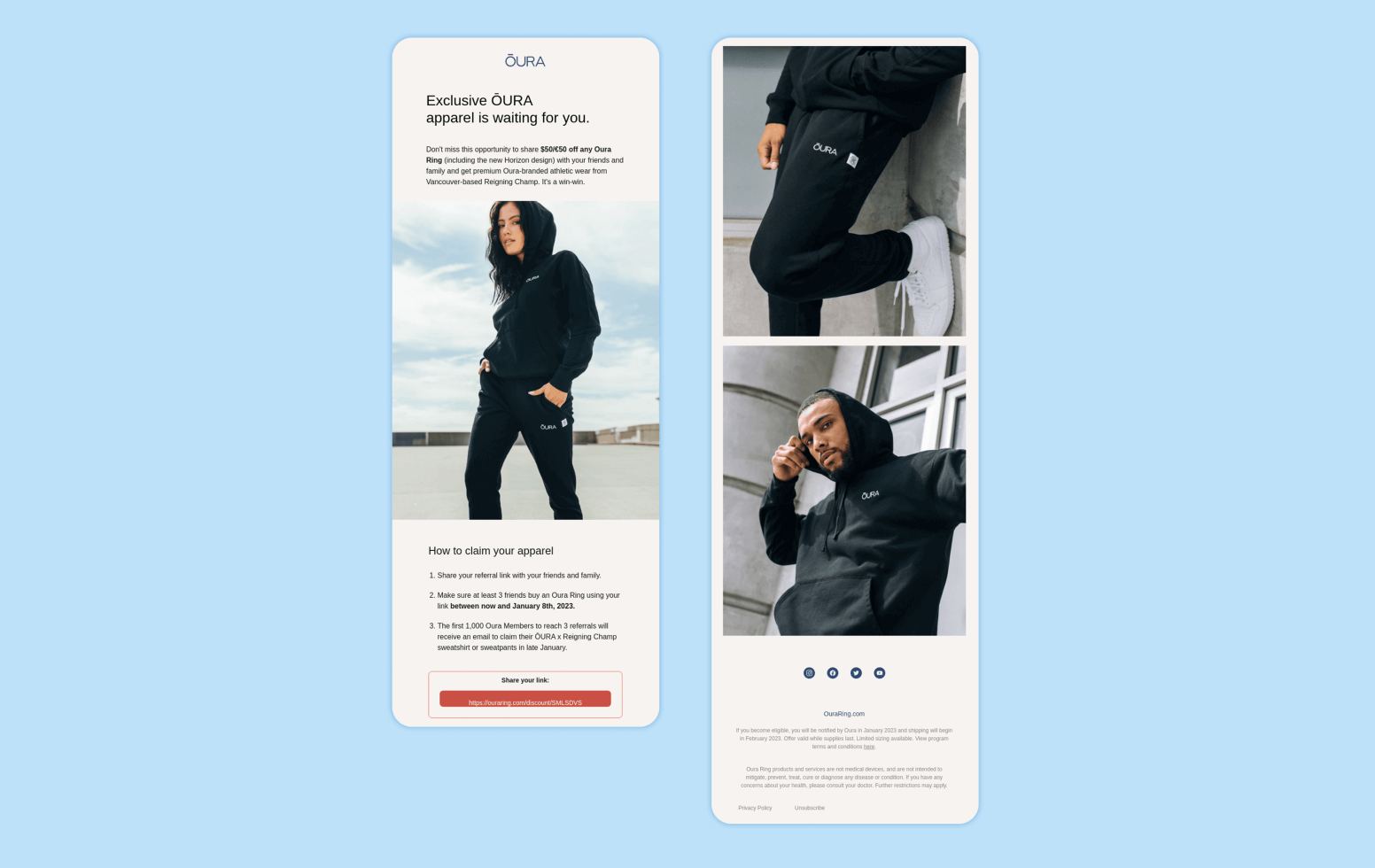
The subject line: “Don’t miss your chance to get exclusive ŌURA apparel, on us” grabs attention with urgency and exclusivity. The sense of urgency is heightened by the deadline. Visually, it’s clean and straightforward, letting the value of the reward do the talking. The copy is minimal yet effective, highlighting that referring just three friends unlocks the reward, making it feel achievable.
This email taps into loyalty psychology by making the offer feel like an insider perk rather than a general promotion. It’s clearly targeted toward existing customers who already value the brand, and the limited-edition reward boosts motivation by playing into exclusivity and social signaling. The low referral threshold adds to its effectiveness by reducing effort for the user.
14. Busuu: Premium Access Referral Email
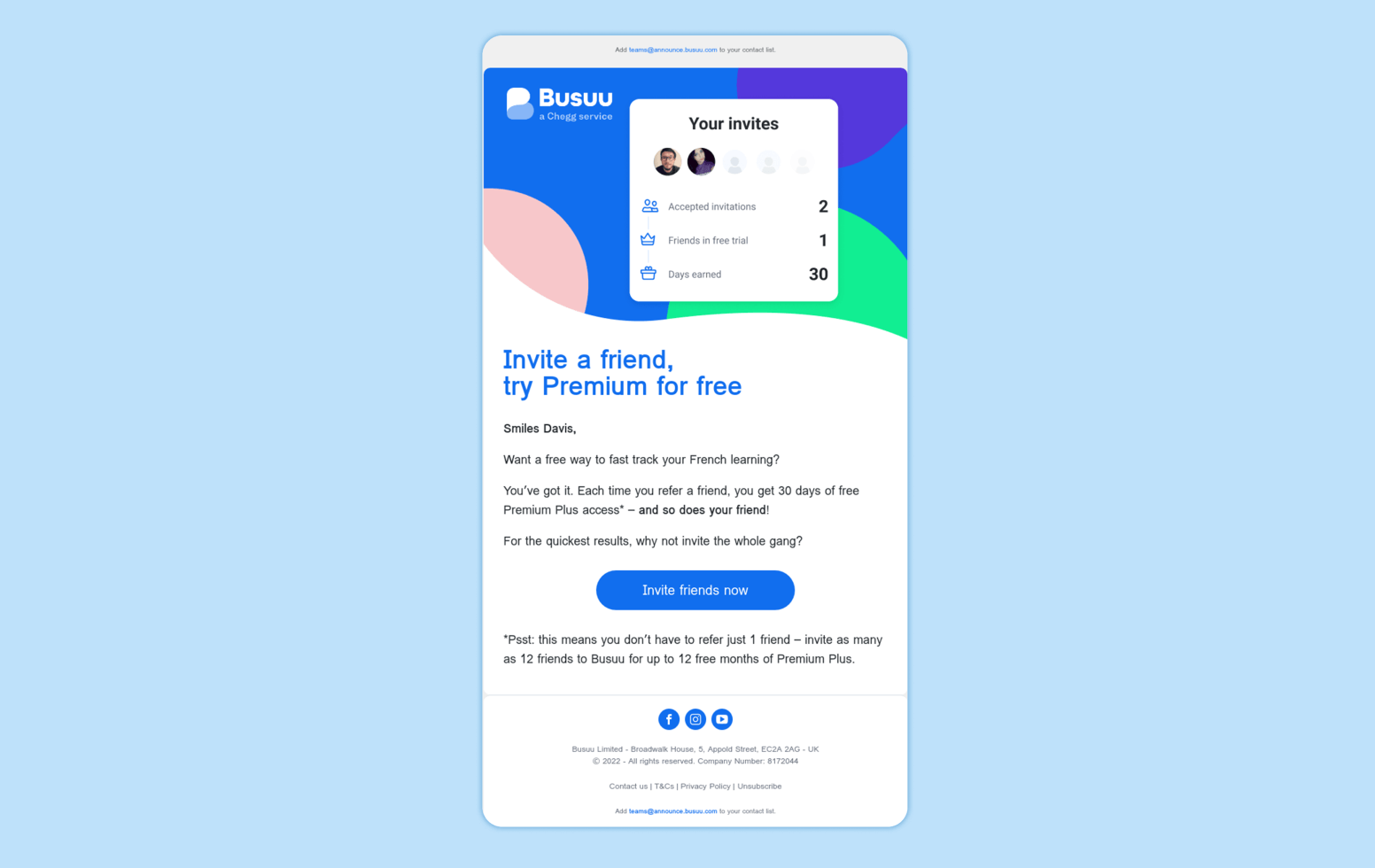
The subject line asks a direct, enticing question: “Want 30 days of free Premium access?” immediately capturing the reader’s interest. The value proposition is crystal clear: invite a friend and get premium access for free. The minimal design and concise copy focus all attention on the main offer, avoiding distractions.
By tying the reward to a high-perceived-value digital benefit (premium access), Busuu smartly targets users already engaging with the product. The email’s clean layout and low barrier to entry make it frictionless for users to participate, especially among digitally native audiences familiar with free trials and freemium models.
15. Postable: Referral Email with Good Visuals
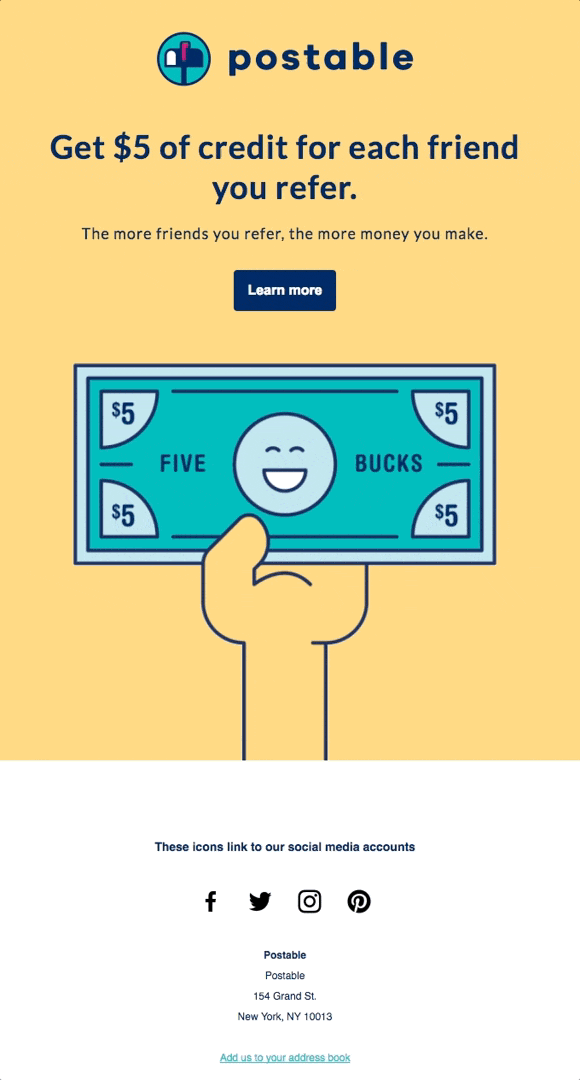
This referral email for Postable uses animation and a simple design to put across the message. The subject line is direct: “Refer your friends and get $$$.” It immediately communicates the value of participating in the program. The visual presentation is clean, and the CTA is easy to spot and act on.
The animation adds a playful, brand-aligned touch without being distracting. By minimizing copy and focusing on aesthetics, the email is mobile-friendly. It also reinforces the notion that referring friends should be as delightful and easy as sending a Postable card.
Use referral emails to supercharge your holiday campaigns—explore these 4th of July email marketing examples for inspiration.
How to Format a Referral Email
A high-performing referral email follows a clean, focused structure designed to drive action. Here’s how to format it effectively:
Headline
- Lead with value and focus on the reward or benefit.
- Make it scannable and bold, as the headline will act as the in-email hook.
- Align the tone with the brand guidelines. It can be friendly, professional, or playful.
Body
- Briefly explain how the referral program works in 2–3 lines or use visual elements.
- Use bullet points or short paragraphs for skimmability.
- Trigger emotion where possible.
- Keep the tone human and persuasive, not overly promotional.
CTA (Call-to-Action)
- Use one strong, visually distinct button.
- Stick to action verbs and a clear benefit.
- Ensure the button is mobile-optimized and stands out from the rest of the email.
Footer
- Include referral program terms and conditions or add a link to them.
- Reassure users that their data and their friends’ info are safe.
- Consider adding light social proof or urgency.
Layout Tip: Use white space, a single-column design, and a clear visual hierarchy. Keep the flow intuitive, focusing on value first and action next.
6 Strategic Referral Email Templates You Can Use
Now that we have seen some of the best referral email examples from different brands, let’s look at six ready-to-use referral email templates you can use.
1. Post-Purchase Referral Email
These emails leverage the follow-up required after any purchase to turn recent buyers into advocates.
“Subject: Loved your order? Invite friends & earn rewards!
Hello [First Name],
Thanks for your recent purchase! Want to share the love among your friends?
For every friend you refer, you’ll both get [reward details].
It’s easy. Just click on the button below to share the unique link.
[Referral CTA Button]“
2. Onboarding Referral Email
Referral emails sent during the email onboarding process engage new users early with the referral program
“Subject: Get rewarded for spreading the word.
Hey [First Name],
Welcome to [Product/Service Name]
We have something special for you.
Invite your friends and get [incentive], while they get [referee reward].
Start sharing now with your link:
[Referral CTA Button – Start Referring]“
3. Milestone Referral Email
Send referral emails when users reach key milestones, such as anniversaries or usage achievements. It shows appreciation and makes them feel valued.
“Subject: You’ve [milestone details]. Let’s celebrate!
Hi [First Name],
You’ve been with us for [X months]. Thank you for your continued support and faith in us.
As a token of appreciation, we’re giving you [reward] for every friend you refer. They’ll get a reward too! [details of the reward]
[Referral CTA Button – Invite Friends & Celebrate]“
4. Exclusive VIP Referral Offer
These referral emails provide exclusive offers to the most loyal or high-value customers to boost sharing.
“Subject: Exclusive: Double the reward for referrals!
Hey [First Name],
You’ve been a rockstar! For [a limited time], you can earn double rewards when you refer your friends.
Your network deserves the best. Share the referral link and earn [reward details].
[Referral CTA Button – Claim Double Rewards]
Offer ends [date]“
5. Time-Sensitive Campaign Email
Time-sensitive referral emails create urgency with a limited-time referral offer to drive quick actions and increase short-term conversions.
“Subject: Ends in 48 hours: ₹500 for you + ₹200 for your friends!
Hi [First Name],
Don’t miss this limited-time offer!
Refer your friends today, and both of you get rewarded.
[Details of both rewards]
This deal ends in 48 hours. Share now before it’s gone.
[Referral CTA Button – Refer Now]“
6. Post-NPS Survey Referral Prompt
Sending referral emails after a satisfaction survey leverages positive feedback from promoters to encourage them to refer friends and amplify word-of-mouth.
“Subject: You love us, why not share the love?
Hi [First Name],
Thanks for your feedback! We’re thrilled you’re enjoying [Product/Service Name].
Want to help friends experience the same? Refer them and you’ll both get [reward details].
[Referral CTA Button – Send Your Link]“
Learn how to use AI in email marketing with our complete guide.
How to Automate Referral Email Campaigns with CleverTap
CleverTap’s email marketing platform enables marketers to seamlessly automate and scale email campaigns using its powerful orchestration, personalization, and analytics capabilities. Here’s how each feature comes together to support effective referral-driven growth:
1. Behavioral Triggers for Timely Email Delivery
With CleverTap, you can use email automation to send referral emails based on real-time user behaviors and lifecycle events. Marketers can trigger email workflows with emails post-purchase, after a successful sign-up, or following positive feedback from an NPS survey. These timely interventions align with high-intent moments in the customer journey, making users more receptive to referring their friends or network.
2. Hyper-Personalized Content with Clever.AI’s Scribe
Using Clever.AI’s content-generation tool Scribe, marketers can create emotionally intelligent, hyper-personalized referral emails that resonate with each recipient. These emails can dynamically incorporate user-specific attributes such as their name, recent purchases, location, or preferred categories, ensuring each message feels personally crafted and significantly increasing open and engagement rates.
3. Real-Time Recommendations to Maximize Referral Relevance
CleverTap analyzes customer behavior and profile data to deliver personalized recommendations that enhance referral campaign content, ultimately improving the overall user experience. For example, if a user recently purchased a specific product, the system can recommend that item as the basis for referral. This type of data-driven email marketing offers contextually relevant targeting that increases the chances of users taking action and referring others to a product or service they value.
4. Journey Builder for End-to-End Referral Flow Automation
With CleverTap’s visual Journey Builder, marketers can create comprehensive referral flows that move users through stages such as discovery, sharing, and reward redemption. You can define event-based triggers, set wait times, add conditional logic, and configure goal tracking to guide users smoothly through the referral process. These journeys ensure a cohesive and automated lifecycle experience from start to finish.
5. Optimize Campaigns with A/B and Multivariate Testing
CleverTap supports both A/B and multivariate testing within email campaigns, allowing marketers to refine and optimize referral communications. By testing different subject lines, call-to-action phrasing, incentive offers, or send times, brands can determine what resonates most with their audience. Once the winning variant is identified, it is automatically sent to the remaining audience for maximum impact.
6. IntelliNode for Send-Time and Frequency Optimization
Powered by Clever.AI, IntelliNode intelligently analyzes user engagement patterns to determine the optimal time and frequency for sending referral emails. This helps marketers avoid email fatigue, increase the likelihood of opens, and boost engagement by reaching users when they are most likely to respond.
7. Omnichannel Reinforcement of Referral Campaigns
While email forms the core of your referral outreach, CleverTap enhances effectiveness by supporting additional channels like push notifications, WhatsApp marketing, in-app messaging, and SMS marketing. For example, you can send reminders to users who didn’t open a referral email or nudge them across other channels if they didn’t share the referral. Reinforcing your message across touchpoints ensures continuity and drives higher conversion throughout the referral journey.
8. Comprehensive Reporting and ROI Measurement
CleverTap provides a robust customer data and analytics tool to help marketers track every stage of a referral campaign. You can view email marketing metrics such as open rates, click-through rates, referral clicks, completed shares, and conversions. Real Impact dashboards go further by calculating revenue uplift, cost savings, and customer lifetime value improvements, giving marketers full visibility into email campaign ROI.
9. Built-in Email Preference Center
To maintain high engagement, improve email deliverability, and reduce unsubscribes, CleverTap includes a customizable Email Preference Center. This feature allows users to manage your email list, their opt-ins, frequency preferences, and interests related to referral campaigns. Ensuring that only the most interested users receive referral emails results in more qualified engagement and better campaign performance.
By integrating these features, CleverTap empowers marketers to execute referral email campaigns that are timely, intelligent, and highly effective. Whether you’re looking to boost acquisition, reward loyal users, or amplify your brand reach, CleverTap delivers the automation, intelligence, and cross-channel execution needed to scale your referral email strategy with precision.
Automate, personalize, and scale email marketing with CleverTap.
Start Building Referral Emails That Convert
Referral emails are a powerful lever for sustainable, cost-effective growth. When done right, they turn your happiest customers into your strongest advocates. By combining clarity, incentive, and trust, as outlined in the A.I.R. framework and using email marketing platforms, you can craft referral emails that not only get opened but also drive action.
Using clear copy, compelling rewards, and a platform like CleverTap to automate and optimize every touchpoint, referral campaigns can become a core part of your growth engine.
Want better performance from your referral emails? Book a demo with CleverTap and optimize your strategy today.
Kiran Pius 
Leads Product Launches, Adoption, & Evangelism.Expert in cross-channel marketing strategies & platforms.
Free Customer Engagement Guides
Join our newsletter for actionable tips and proven strategies to grow your business and engage your customers.















































